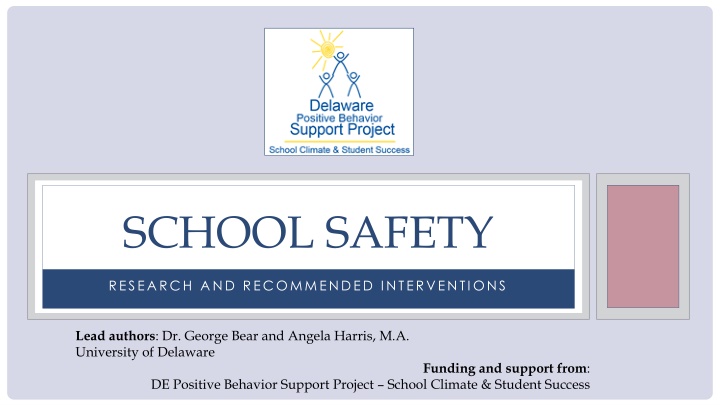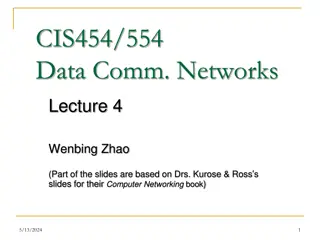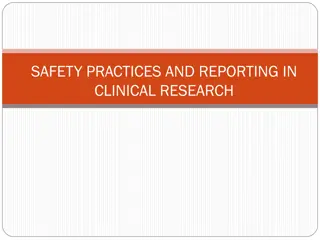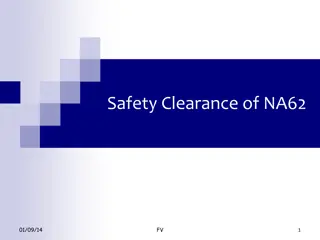
School Safety Research and Recommended Interventions Overview
Explore the concept of school safety, its impact on students and staff, and indicators of school safety from recent reports. Learn about the Delaware School Surveys' subscale on school safety and important considerations for improving school climate and behavioral outcomes.
Download Presentation

Please find below an Image/Link to download the presentation.
The content on the website is provided AS IS for your information and personal use only. It may not be sold, licensed, or shared on other websites without obtaining consent from the author. If you encounter any issues during the download, it is possible that the publisher has removed the file from their server.
You are allowed to download the files provided on this website for personal or commercial use, subject to the condition that they are used lawfully. All files are the property of their respective owners.
The content on the website is provided AS IS for your information and personal use only. It may not be sold, licensed, or shared on other websites without obtaining consent from the author.
E N D
Presentation Transcript
SCHOOL SAFETY RESEARCH AND RECOMMENDED INTERVENTIONS Lead authors: Dr. George Bear and Angela Harris, M.A. University of Delaware Funding and support from: DE Positive Behavior Support Project School Climate & Student Success
MODULE STRUCTURE Module series goal: Provide information to schools that can lead to improvements in school climate and behavioral outcomes. Module narratives provide additional information to accompany PowerPoint Presentation. Endnotes throughout slides correspond to the references in the module narrative. Gold star = Resource on Delaware PBS website
SCHOOL SAFETY Refers to the actual safety of students, teachers, and other in school, but also to their perceptions of safety In safe schools: Students experience few, if any, acts of violence or other acts that are harmful to their physical and emotional well-being Emotional harm, such as high levels of fear, anxiety, sadness, anger, and avoidance of school can be lasting Students and staff feel safe from acts of violence and other harmful actions such as bullying In unsafe schools: Harm is experienced by those who are victims or who fear violence and other acts that threaten safety and by witnesses of violent and traumatic events1 Outcomes can be more serious and tragic
DELAWARE SCHOOL SURVEYS School safety is one of multiple subscales on the Delaware School Climate Scale of the Delaware School Surveys (DSS) Appears on the student, teacher/staff, and home surveys Consists of three items that assess perceptions of safety: Students are safe in the hallways Students feel safe Students know they are safe in this school
ESTIMATES AND INDICATORS OF SCHOOL SAFETY Depend greatly on how being safe is defined Indicators of school safety reported in the 2018 NCES Indicators of School Crime and Safety: 2017 report2 During the 2014-15 school year, 20 students were victims of homicides and 9 of suicides In the 2017-18 school year, 29 students died from 17 school shootings in K-12 settings33 About 15% of public schools report 1 or more serious violent crimes E.g., rape, sexual assault, robbery, physical attack/fight with a weapon When fights or physical attacks (without a weapon) and threats of physical attacks with or without a weapon are added as violent incidents, the percentage of schools reporting one or more of these incidents increases substantially Fighting and physical attacks without a weapon are the most commonly reported incidents (64.9% of public schools)
ESTIMATES AND INDICATORS OF SCHOOL SAFETY Despite those statistics, schools are among the safest places for students and staff, especially when compared to other places and causes of injury and death3-4 For example The rate of the aforementioned serious violent incidents is less than 1 crime per 100 students Approximately 97% of student homicides occur outside of school, and approximately 1 student homicide or suicide at school occurs for every 1.9 million students Students are more likely to be killed or seriously injured in their homes or community, riding a bicycle, swimming, and especially riding in vehicles5
SOARE SCHOOLS SAFE? Overall, schools are quite safe from events that involve death, serious physical harm, and serious violence If all types of crimes (violent & non-violent) are viewed as indicators of school safety, schools vary greatly with respect to safety E.g., theft, vandalism; illegal and prescription drug/alcohol activity; possession of a firearm or explosive device; possession of a knife or sharp object Approximately 79% of public schools reported such crimes in 2015-16 The NCES report includes additional indicators of safety, such as: Gangs at school Hate language and hate-related graffiti Teachers reports of being threatened and student actions that interfere with teaching Disciplinary problems and serious disciplinary problems (e.g., expelling a student)
SCHOOL SAFETY IN DELAWARE Data reported by the Delaware DOE indicates that schools in Delaware are safe In the 2016-17 school year, 806 school crimes were reported in public schools6 Felonies, misdemeanors, or violations defined in the Delaware Code This equals approximately 6 school crimes per 1,000 students According to the Delaware School Surveys in 2018: 84% of students 93% of teachers/staff 95% of parents Agreed with the statement: Students know they are safe in this school.
Classroom, School, and Teacher Characteristics School Safety Contributing Factors
CLASSROOM, SCHOOL, & TEACHER CHARACTERISTICS CONTRIBUTING FACTORS Students and teachers/staff tend to feel safer in schools in which the following are present: Clear and fair rules and expectations for behavior. Including clear and fair policies for addressing school violence7-10,34 Cleanly and well-maintained school facilities, displayed student work, bulletin boards11,15 Physical safety features, especially security cameras, secure entrances, and locked doors8,11 Research is not always consistent35,36 Little evidence that school resource officers (SROs) and police increase perceptions of safety.4 Interactions with SROs that are respectful, fair, and genuine are likely to be viewed as positive experiences by students.12-14 Teachers and staff who are highly visible, especially in areas prone to violence/crime8 Positive teacher-student, student-student, home-school, and staff relationships
CLASSROOM, SCHOOL, & TEACHER CHARACTERISTICS CONTRIBUTING FACTORS Students and teachers/staff tend to feel safer in schools in which the following are present: Students are cognitively, emotionally, and behaviorally engaged in school Efforts are made to develop students social and emotional competencies, both school-wide and in individual classrooms An overall positive school climate8,16
Collect and analyze data Provide PD on school safety Avoid simple & quick fixes Review school crisis procedures Comprehensive school discipline School Safety Recommended Strategies Individuals and procedures for assessing threats Authoritative school discipline Prevent misbehavior from reoccurring Teach social and emotional competencies Review procedures for helping students Increase students awareness to threats and how to report
COLLECT AND EXAMINE DATA RECOMMENDED STRATEGIES Collect and analyze data, especially school climate data, related to school safety E.g., the Delaware School Climate Scale of the DSS Results of the surveys would help answer the critical question: Is my school perceived as being safe across students, teachers/staff, and parents, and across subgroups within those respondents, including grades (e.g., 9th versus 12th grade), racial/ethnic groups, and gender? Finding positive perceptions = little or no need for interventions that follow, especially if other data support those perceptions Finding negative perceptions across multiple subgroups = need for efforts to improve school safety Finding negative perceptions across specific subgroups = need for more targeted interventions and deeper information gathering
COLLECT AND EXAMINE DATA RECOMMENDED STRATEGIES Examine responses to specific survey items, especially on the School Safety subscale Will help determine which interventions are most appropriate Examine other sources of data related to school safety Office disciplinary referrals, suspensions and expulsions, absences, police reports and arrests Generally, data should be disaggregated by behavior, person making the referral, and student demographics Share results of surveys and other data with focus groups comprised of representatives that responded unfavorably to the items
CONDUCTING FOCUS GROUPS Focus group guide Information on: Designing questions Recruiting participants Conducting the group Analyzing data Provides examples from Duke University (https://assessment.trinity.duke.edu/documents/How_to_Con duct_a_Focus_Group.pdf)
AVOID SIMPLE & QUICK FIXES RECOMMENDED STRATEGIES Some common quick fixes that are typically ineffective Student profiling Creating a list of students who are most likely to engage in a given act is unreliable and falsely identifies students as being threats to safety17-18 School uniforms, strict dress codes, and ID badges Research is lacking on the effectiveness of these practices on school safety Often, these practices make schools less pleasant places to be Pervasive zero tolerance approach Reasonable school policies make schools safer A pervasive zero tolerance approach (e.g., suspension without consideration of circumstances and for relatively minor misbehavior) seldom improves safety and creates poor school climate This is also true for observable security measures that enforce pervasive zero tolerance approaches (e.g., school resource officers & metal detectors).19Currently it is unknown if such measures increase or decrease school safety.20-21
COMPREHENSIVE SCHOOL DISCIPLINE RECOMMENDED STRATEGIES A comprehensive approach to school discipline includes four components:22-23 1. Strategies for developing social and emotional competencies, especially those related to self-discipline 2. Strategies for preventing behavior problems 3. Strategies for correcting common behavior problems 4. Programs and strategies for responding to serious and chronic behavior problems Components are interrelated, but should be viewed as distinct
AUTHORITATIVE SCHOOL DISCIPLINE RECOMMENDED STRATEGIES Research shows that an authoritative approach prevents behavior problems and characterizes safe schools.24-25 Consists of a balance of structure and social support Structure Social Support High behavioral and academic expectations, clear and fair rules and consequences, and close monitoring and supervision of students Strict punitive policies (e.g., expulsion for weapons) and reasonable safety measures (e.g., locked doors) Building and maintaining positive teacher-student and student-student relationships that make all students feel accepted, respected, and a sense of belonging and support from others
TEACH SOCIAL AND EMOTIONAL COMPETENCIES RECOMMENDED STRATEGIES The teaching of social and emotional skills should be integrated throughout the curriculum and included in classroom management practices For example, lessons on empathy, responsible decision making, and peer pressure should be covered in literacy courses, social studies, and elsewhere Such lessons might be supplemented with lessons from an evidence-based program from social and emotional learning, such as Second Step.
SOCIAL-EMOTIONAL LEARNING IN THE CURRICULUM Includes ideas and a template for incorporating SEL into the curriculum Provides an example of an academic content standard, pre- existing academic lesson, and social-emotional topic that can be tied into the lesson Action planning section helps educators to brainstorm ways that SEL can be tied into existing lessons and academic content standards
INCREASE AWARENESS OF THREATS AND HOW TO REPORT RECOMMENDED STRATEGIES Schools can help prevent the most serious acts of violence by increasing students awareness of threats to safety, helping them recognize their responsibility to report it, and knowing how to report it. Communicate these messages while not inducing unnecessary fear, such as scare tactics This information might be presented in the context of social emotional learning curriculum or other lessons or discussions It might also be taught/reinforced via: School assemblies, special projects, posters, school announcements, pledges taken by students, and school media Common reasons bystanders fail to intervene & report potential acts of violence:19 They do not believe the perpetrator is serious They do not foresee the seriousness of the threat They do not accept responsibility for intervening They fear retaliation They believe no one will do anything about it They do not know how to report it
REVIEW PROCEDURES FOR HELPING STUDENTS RECOMMENDED STRATEGIES Pertains to students at Tiers 2 & 3 and all students who engage in acts that make schools unsafe (e.g., those who possess drugs, bully, are depressed or suicidal, etc.) Questions that should be addressed are Who in the school provides mental health, including threat assessment, interventions, and crisis responses services? Do they have sufficient time to provide needed services? To what extent does close coordination and collaboration of services exist between the school and various outside agencies, including social services, child protective services, mental health agencies, and law enforcement? When, and how, are outside resources obtained? What services exist within the school (e.g., mental health interventions), and which ones are lacking, based on student needs? Do teachers/staff have the knowledge, skills, and awareness to recognize students who need services? Do teachers/staff have adequate time to address students needs, and administrative support in doing so? What are the procedures for students to receive needed services? Are services available, such academic and mental health services for students with behavior problems? Are students, parents, teachers, and other staff aware of the procedures? Are services easily requested and delivered in a reasonable period of time?
INVENTORY FOR POLICIES, PROCEDURES, AND RESOURCES FOR STUDENTS WITH INTENSIVE MENTAL HEALTH NEEDS Helps assess the extent to which policies, procedures, and resources for students with intensive mental health needs are in place in a particular school Can be used by school teams to address any areas that are not in place or need to be improved
PREVENT MISBEHAVIOR FROM REOCCURRING RECOMMENDED STRATEGIES This applies to more serious acts that justify a referral to the office or suspension (in school or out of school) When this type of misbehavior occurs, develop a plan with the student to help prevent the misbehavior from reoccurring. The plan should consist of two parts:23 Part 1: Part 2: What can the teacher(s), the school, and the home do differently that would help prevent the behavior from reoccurring? What does the student need to do differently? What skills need to be developed and exhibited?
PROFESSIONALLY TRAINED INDIVIDUALS AND PROCEDURES IN PLACE FOR ASSESSING THREATS RECOMMENDED STRATEGIES Highly recommended that more than 1 trained individual is available at all times Mental health professionals (e.g., school psychologists) School administrators Law enforcement or school resource officers Primary goal of threat assessment interview: Determine seriousness of threat and need for follow-up actions (e.g., contacting parents and law enforcement) Effective threat assessments avoid over-reactions and under-reactions to threats19 Also deter other students from acts of violence by making them aware that their threats are taken seriously29
REVIEW SCHOOL CRISIS PREVENTION AND RESPONSE PROCEDURES RECOMMENDED STRATEGIES Schools should have a school crisis team and crisis plan in place that addresses crisis prevention, preparedness, emergency response, and recovery capacities National Association of School Psychologists (NASP) PREPaRE crisis curriculum: assists in strengthening school crisis plans26 (see next slide) Crisis teams should be multidisciplinary: School representation: administrators, teachers, school psychologists, nurses, counselors, school resource officers, transportation managers, and family service representatives Community representation: parents, law enforcement, EMS, fire officials, and mental health practitioners Crisis plans should include 4 stages of crisis management: Preparedness Prevention Response Recovery
NASP PREPaRE MODEL Prevent and prepare for psychological trauma Reaffirm physical health and perceptions of security and safety Evaluate psychological trauma risk Provide interventions and Respond to psychological needs Examine the effectiveness of crisis prevention and intervention http://www.nasponline.org/professional- development/prepare-training-curriculum
PROVIDE PROFESSIONAL DEVELOPMENT ON SCHOOL SAFETY RECOMMENDED STRATEGIES Training for all teachers and staff should include each of the topics in the recommendations presented previously, especially preventing school violence with an authoritative approach to discipline, crisis response strategies, and awareness of threats of violence. Training also should include: Suicide prevention and intervention Bullying prevention and intervention (including cyberbullying) Conflict resolution techniques Restorative practices Trauma-informed practices Home-school collaboration and communication How to respond to threats of violence Resources and supports for students, teachers/staff, and parents Relationship between school climate and school violence Role of law enforcement and working collaboratively Security measures in the building Where appropriate, the role of gang affiliation in matters of school safety
THANK YOU Based on areas of need identified by data, check out other modules and resources provided through the School Climate and Student Success Module Series. www.delawarepbs.org Questions can be directed to Sarah Hearn skhearn@udel.edu
SCHOOL SAFETY Lead Authors: Dr. George Bear and Angela Harris, M.A. University of Delaware & Delaware Positive Behavior Support Project Research Narrative Reviewed by: Dr. Aaron Kupchik University of Delaware PowerPoint Developed and Reviewed by: Angela Harris and Fiona Lachman University of Delaware & Delaware Positive Behavior Support Project Audio Recorded by: Fiona Lachman Funding and Support from: The Delaware Department of Education through the Delaware Positive Behavior Support Project and the School Climate and Student Success Grant






















